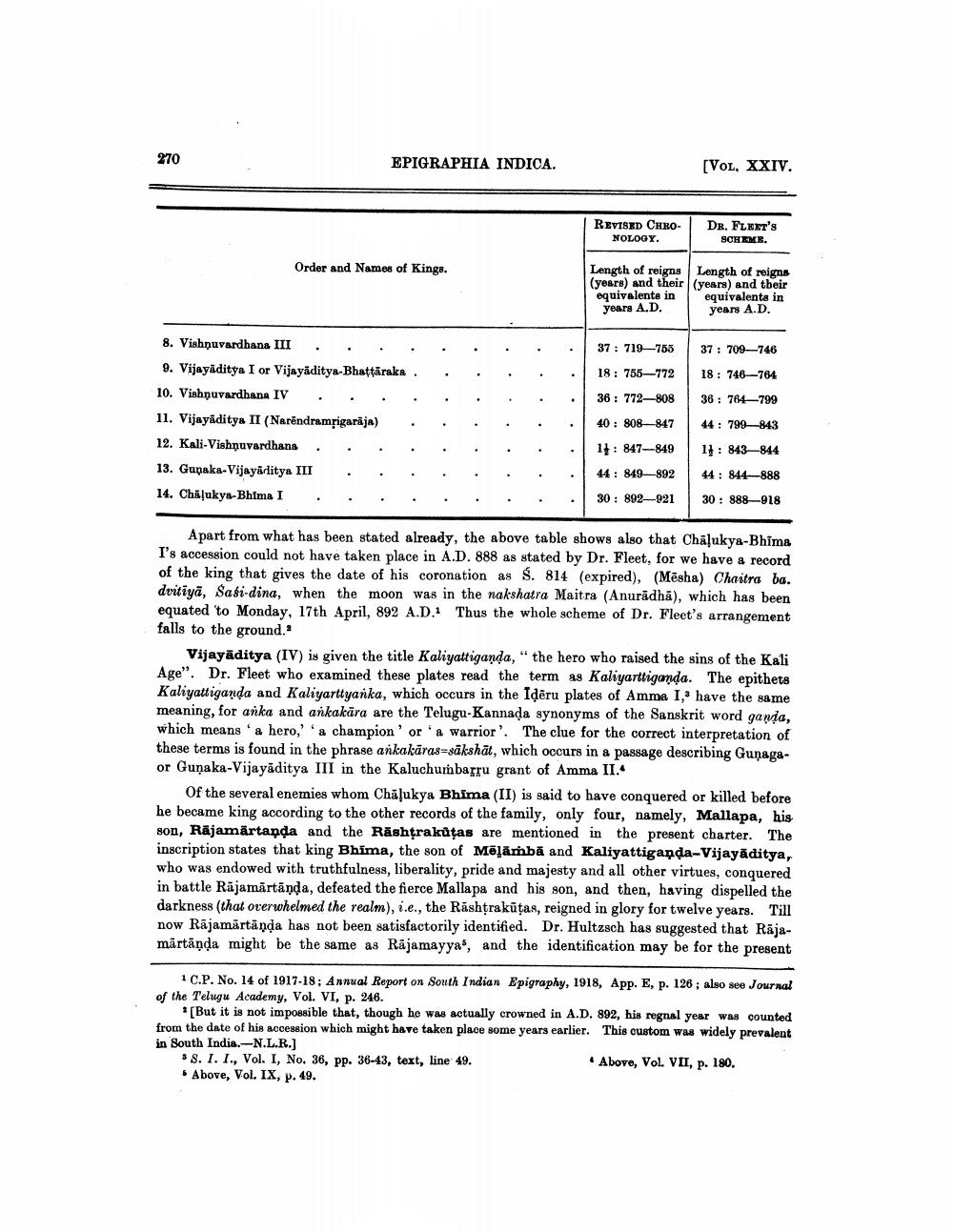________________
270
EPIGRAPHIA INDICA.
(VOL. XXIV.
REVISED CHRO
NOLOGY.
DR. FLERT'S
SCHEME.
Order and Names of Kings.
Length of reigns | Length of reigns (years) and their (years) and their equivalente in equivalente in years A.D. years A.D.
. .
. .
. .
.
8. Vishnuvardhana III . . . . 9. Vijayaditya I or Vijayaditya-Bhattāraka . 10. Vishnuvardhana IV . . . . 11. Vijayaditya II (Narendramrigarāja) . 12. Kali-Vishnuvardhana . . . . 13. Gunaka-Vijayārlitya III . . . 14. Chāļukya-Bhima I . . . .
. . . . .
37: 719—755 18 : 755—772 36 : 772–808 40 : 808-847 11: 847-849 44: 849—892
37 : 709—746 18 : 746—764 36 : 764-799 44 : 799–843 11: 843-844 44: 844-888 30 : 888918
.
.
.
.
.
30: 892_921
Apart from what has been stated already, the above table shows also that Chāļukya-Bhima I's accession could not have taken place in A.D. 888 as stated by Dr. Fleet, for we have a record of the king that gives the date of his coronation as $. 814 (expired), (Mēsha) Charitra ba. dvitiyā, Sasi-dina, when the moon was in the nakshatra Maitra (Anuradhā), which has been equated 'to Monday, 17th April, 892 A.D. Thus the whole scheme of Dr. Fleet's arrangement falls to the ground.'
Vijayāditya (IV) is given the title Kaliyattiganda," the hero who raised the sins of the Kali Age". Dr. Fleet who examined these plates read the term as Kaliyarttiganda. The epithets Kaliyattiganda and Kaliyarttyanka, which occurs in the Idēru plates of Amma 1,have the same meaning, for arka and ankakāra are the Telugu-Kannada synonyms of the Sanskrit word gawia, which means ' a hero,' 'a champion' or ' a warrior'. The clue for the correct interpretation of these terms is found in the phrase ankakāras=sākshāt, which occurs in a passage describing Guņagaor Gunaka-Vijayaditya III in the Kaluchumbarru grant of Amma II.
Of the several enemies whom Chalukya Bhima (II) is said to have conquered or killed before he became king according to the other records of the family, only four, namely, Mallapa, his son, Rājamārtanda and the Rāshtrakūtas are mentioned in the present charter. The inscription states that king Bhima, the son of Mēlambă and Kaliyattiganda-Vijayāditya, who was endowed with truthfulness, liberality, pride and majesty and all other virtues, conquered in battle Räjamärtända, defeated the fierce Mallapa and his son, and then, having dispelled the darkness (that overwhelmed the realm), i.e., the Rashtrakūtas, reigned in glory for twelve years. Till now Rājamārtānda has not been satisfactorily identified. Dr. Hultzsch has suggested that Rājamärtända might be the same as Rājamayya', and the identification may be for the present
C.P. No. 14 of 1917-18: Annual Report on South Indian Epigraphy, 1918, App. E, p. 126 ; also see Journal of the Telugu Academy, Vol. VI, p. 246.
* [But it is not impossible that, though he was actually crowned in A.D. 892, his regnal year was counted from the date of his accession which might have taken place some years earlier. This custom was widely prevalent in South India.-N.L.R.) 38. I. I., Vol. I, No. 36, pp. 36-43, text, line 49.
Above, Vol. VII, p. 180. • Above, Vol. IX, p. 49.




